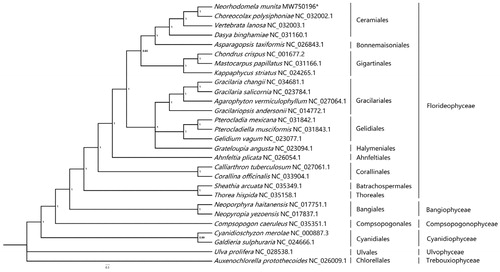Abstract
Neorhodomela munita (Perestenko) Masuda 1982 is distributed in the coastal areas of Shandong and Liaoning in China, and also in Japan. In this study, the complete nucleotide sequence of the circular mitochondrial DNA of the red alga Neorhodomela munita has been determined. The complete mitochondrial DNA sequence of Neorhodomela munita was 25,318 bp in length with an overall GC content of 25.1% and encoded 23 protein-coding genes, two ribosomal RNAs and 24 transfer RNAs. Phylogenetic tree showed that Neorhodomela munita clustered together with Choreocolax polysiphoniae. The phylogenetic analysis may provide a better understanding of the evolution of the Rhodophyta species.
Neorhodomela munita (Perestenko) Masuda 1982 belongs to Neorhodomela (Rhodomelaceae; Ceramiales; Florideophyceae; Rhodophyta). It is distributed in the coastal areas of Shandong and Liaoning in China, and also in Japan (Bangmei Citation2011). It mainly lives in swamps of intertidal zone and rocks, and plays an important role in the ecological environment of intertidal zone. As a unique group of organisms evolving from prokaryotes and eukaryotes, algae are the key to decipher the origin and evolution of eukaryotes. As the product of the first endosymbiosis, mitochondrial genomes can provide nucleotide or amino acid sequence data for phylogenetic analysis, and many structural characteristics (such as genome size, GC content, gene content, and genome collinearity) can directly provide evidence for system development (Martin and Russell Citation2003; Robba et al. Citation2006). In this study, we sequenced, assembled, and annotated the mitochondrial DNA of Neorhodomela munita, conducted a systematic genome study to reveal the evolutionary of its mitochondrial DNA, and studied the phylogenetic relationships with several other algae.
Neorhodomela munita was collected from Badaguan Area, Qingdao, Shandong Province, China (36°02′57′′N, 120°20′52′′E), and stored in −80 °C refrigerator at the Culture Collection of Seaweed at the Ocean University of China (Tao Liu, [email protected]) under the voucher number 2016040001. The determination of the complete Neorhodomela munita mitochondrial genome sequence was conducted by next-generation sequencing methods. Total DNA was extracted by using the modified CTAB method (Doyle and Doyle Citation1990). Paired-end reads were sequenced with the use of Illumina HiSeq Ten system (Illumina, San Diego, CA). The experimental methods and data analysis were followed by the previous reports (Tamura et al. Citation2013; Liu et al. Citation2019).
The complete mitochondrial genome of Neorhodomela munita is a circular DNA molecule with the length of 25,318 bp (GenBank accession number: MW750196). Overall, GC content of the complete mitochondrial genome was 25.1%. The mitogenome contained 49 genes (23 protein-coding genes, two rRNAs, and 24 tRNAs). The nucleotide consisted of 39.7% A, 12.9% G, 35.3% T, and 12.2% C. The length of coding region accounted for 91.44% of the total length. All the 23 protein-coding genes of Neorhodomela munita use ATG as the start codon. Twenty of 23 (86.96%) protein-coding genes (nad4L, cox2, cox3, atp4, cob, nad6, sdhB, sdhC, atp9, rps11, nad3, nad1, nad2, sdhD, nad4, nad5, atp8, atp6, tatC, and rps12) end with the TAA stop codon, and three of 23 (13.04%) protein-coding genes (rps3, rpl16, and cox1) end with TAG.
To construct the concatenated alignment of mitochondrial genes, conserved 12 protein-coding genes (atp6, cox1, cox2, cox3, cytb, nad1, nad2, nad3, nad4, nad4L, nad5, and nad6) from 26 red algae and two green algae including Neorhodomela munita were used, and the gene sets were aligned by MrBayes version 3.1.2 software, Uppsala, Sweden (Ronquist and Huelsenbeck Citation2003). The phylogenetic analysis was run until the average standard deviation of split frequencies was below 0.01. Auxenochlorella protothecoides (NC_026009.1) and Ulva prolifera (NC_028538.1) served as the out-group. Poorly aligned regions were removed by using the Gblocks server (Castresana Citation2000). Phylogenetic tree showed that all red algal taxa were clearly separated according to their original class (). In phylogenetic tree, Neorhodomela munita has the closest relationship with Choreocolax polysiphoniae, followed by the Vertebrata lanosa and Dasya binghamiae in order Ceramiales. At class Rhodophyta level, Ceramiales, the order of Neorhodomela munita, is more closely related to Bonnemaisoniales. This complete mitochondrial genome analysis of Neorhodomela munita will help us better understand the evolutionary process of Rhodophyta species.
Disclosure statement
No potential conflict of interest was reported by the author(s).
Data availability statement
The genome sequence data that support the findings of this study are openly available in GenBank of NCBI at [https://www.ncbi.nlm.nih.gov] (https://www.ncbi.nlm.nih.gov/) under the accession no.MW750196.
Additional information
Funding
References
- Bangmei X. 2011. Algae of China. Vol. 2. Rhodophyta. Vol. 7, Ceramiales Rhodomelaceae. Beijing, China: Science Press.
- Castresana J. 2000. Selection of conserved blocks from multiple alignments for their use in phylogenetic analysis. Mol Biol Evol. 17(4):540–552.
- Doyle JJ, Doyle JL. 1990. Isolation of plant DNA from fresh tissue. Focus. 12:13–15.
- Liu T, Tang X, Jia X, Wu X, Huang M, Zeng J, Chen W. 2019. The complete plastid genome and phylogenetic analysis of Gracilaria spinulosa. Mitochondrial DNA B Resour. 4(2):2606–2607.
- Martin W, Russell MJ. 2003. On the origins of cells: a hypothesis for the evolutionary transitions from abiotic geoehemisty to chemoautotrophic prokayrotes, and from prokaryotes to nucleated cells. Philos Trans R Soc Lond B Biol Sci. 358(1429):59–83.
- Ronquist F, Huelsenbeck JP. 2003. Mrbayes 3: Bayesian phylogenetic inference under mixed models. Bioinformatics. 19(12):1572–1574.
- Robba L, Russell SJ, Barker GL, Brodie J. 2006. Assessing the use of the mitochondrial cox1 marker for use in DNA barcoding of red algae (Rhodophyta). Am J Bot. 93(8):1101–1108.
- Tamura K, Stecher G, Peterson D, Filipski A, Kumar S. 2013. MEGA6: molecular evolutionary genetics analysis version 6.0. Mol Biol Evol. 30(12):2725–2729.

